#mycenaean greek
Text
Mycenaean Greek
(and examples of lexical evolution to Modern Greek)
Mycenaean Greek is the most ancient attested form of the Greek language (16th to 12th centuries BC). The language is preserved in inscriptions of Linear B, a script first attested on Crete before the 14th century BC. The tablets long remained undeciphered and many languages were suggested for them until Michael Ventris, building on the extensive work of Alice Kober, deciphered the script in 1952. This turn of events has made Greek officially the oldest recorded living language in the world.
What does this mean though? Does it mean that a Modern Greek could speak to a resurrected Mycenaean Greek and have an effortless chat? Well obviously not. But we are talking about the linear evolution of one single language (with its dialects) throughout time that was associated with one ethnic group, without any parallel development of other related languages falling in the same lingual branch whatsoever.
Are we sure it was Greek though? At this point, yes, we are. Linguists have found in Mycenaean Greek a lot of the expected drops and innovations that individualised the Hellenic branch from the mother Proto-Indo-European language (PIE). In other words, it falls right between PIE and Archaic Greek and resembles what Proto-Greek is speculated to have been like. According to Wikipedia, Mycenaean Greek had already undergone all the sound changes particular to the Greek language.
Why was it so hard to decipher Linear B and understand it was just very early Greek? Can an average Greek speaker now read Linear B? No. An average Greek speaker cannot read Linear B unless they take into account and train themselves on certain rules and peculiarities that even took specialized linguists ages to realise and get used to. Here's the catch: Linear B was a script inspired by the Minoan Linear A, both of which were found in the Minoan speaking Crete. (Minoan Linear A inscriptions have yet to be deciphered and we know nothing about them.) The Mycenaeans (or was it initially the Minoans???) made only minimal modifications to produce the Linear B script and used it exclusively for practical purposes, namely for accounting lists and inventories. Linear B however was an ideographic and syllabic script that stemmed from a script that originally was not designed to render the Mycenaean Greek language, and thus it could not do it perfectly. In other words, the script itself does not render the Greek words accurately which is what made it extremely hard even for the linguists to decipher these inscriptions. Due to its limited use for utility and not for prose, poetry or any other form of expression, the Mycenaean Greeks likely did not feel compelled to modify the script heavily into some more appropriate, accurate form to cover the language's needs.
Examples of the script's limitations:
I won't mention them all but just to give you an idea that will help you then read the words more easily:
In the syllabic script Linear B, all syllable symbols starting with a consonant obligatorily have a vowel following - they are all open sylllables without exception. Linear B can NOT render two consonants in a row which is a huge handicap because Greek absolutely has consonants occuring in a row. So, in many cases below, you will see that the vowel in the script is actually fake, it did not exist in the actual language, and I might use a strikethrough to help you out with this.
For the same reason, when there are consonants together, at least one of them is often casually skipped in Linear B!
There were no separate symbols for ρ (r) and λ (l). As a result, all r and l sounds are rendered with the r symbol.
Exactly because many Greek words end in σ, ς (sigma), ν (ni), ρ (rho) but in Linear B consonants must absolutely be followed by a vowel, a lot of time the last letter of the words is skipped in the script!
Voiced, voiceless and aspirate consonants all use the same symbols, for example we will see that ka, ha, gha, ga all are written as "ka". Pa, va, fa (pha), all are written as "pa". Te, the are written as "te".
There are numerous other limitations but also elements featured that were later dropped from the Greek language, i.e the semivowels, j, w, the digamma, the labialized velar consonants [ɡʷ, kʷ, kʷʰ], written ⟨q⟩, which are sometimes successfully represented with Linear B. However, that's too advanced for this post. I only gave some very basic, easy guidelines to help you imagine in your mind what the word probably sounded like and how it relates to later stages of Greek, and modern as is the case here. That's why I am also using simpler examples and more preserved vocabulary and no words which include a lot of these early elements which were later dropped or whose decoding is still unclear.
Mycenaean Linear B to Modern Greek vocabulary examples:
a-ke-ro = άγγελος (ágelos, angel. Notice how the ke symbol is representing ge, ro representing lo and the missing ending letter. So keep this in mind and make the needed modifications in your mind with the following examples. Also, angel actually means "messenger", "announcer". In the Christian context, it means "messenger from God", like angels are believed to be. So, that's why it exists in Mycenaean Greek and not because Greeks invented Christianity 15 centuries before Jesus was born XD )
a-ki-ri-ja = άγρια (ághria, wild, plural neuter. Note the strikethrough for the nonexistent vowel)
a-ko-ro = αγρός (aghrós, field)
a-ko-so-ne = άξονες (áksones, axes)
a-na-mo-to = ανάρμοστοι (anármostoi, inappropriate, plural masculine. Note the skipped consonants in the script)
a-ne-mo = ανέμων (anémon, of the winds)
a-ne-ta = άνετα (áneta, comfortable, plural neuter, an 100% here, well done Linear B!)
a-po-te-ra = αμφότερες (amphóteres, or amphóterae in more Archaic Greek, both, plural feminine)
a-pu = από (apó, from)
a-re-ka-sa-da-ra = Αλεξάνδρα (Alexandra)
de-de-me-no = (δε)δεμένο (ðeðeméno, tied, neuter, the double de- is considered too old school, archaic now)
do-ra = δώρα (ðóra, gifts)
do-ro-me-u = δρομεύς (ðroméfs, dromeús in more Archaic Greek, runner)
do-se = δώσει (ðósei, to give, third person singular, subjunctive)
e-ko-me-no = ερχόμενος (erkhómenos, coming, masculine)
e-mi-to = έμμισθο (émmistho, salaried, neuter)
e-ne-ka = ένεκα (éneka, an 100%, thanks to, thanks for)
e-re-mo = έρημος (érimos, could be pronounced éremos in more Archaic Greek, desert)
e-re-u-te-ro-se = ελευθέρωσε (elefthérose, liberated/freed, simple past, third person)
e-ru-to-ro = ερυθρός (erythrós, red, masculine)
e-u-ko-me-no = ευχόμενος (efkhómenos or eukhómenos in more Archaic Greek, wishing, masculine)
qe = και (ke, and)
qi-si-pe-e = ξίφη (xíphi, swords)
i-je-re-ja = ιέρεια (iéreia, priestess)
ka-ko-de-ta = χαλκόδετα (και όχι κακόδετα!) (khalkóðeta, bound with bronze, plural neuter)
ke-ka-u-me-no = κεκαυμένος (kekafménos, kekauménos in more Archaic Greek, burnt, masculine)
ke-ra-me-u = κεραμεύς (keraméfs, kerameús in more Archaic Greek, potter)
ki-to = χιτών (khitón, chiton)
ko-ri-to = Κόρινθος (kórinthos, Corinth)
ku-mi-no = κύμινο (kýmino, cumin)
ku-pa-ri-se-ja = κυπαρίσσια (kyparíssia, cypress trees)
ku-ru-so = χρυσός (khrysós, gold)
ma-te-re = μητέρα (mitéra, mother)
me-ri = μέλι (méli, honey)
me-ta = μετά (metá, after / post)
o-ri-ko = ολίγος (olíghos, little amount, masculine)
pa-ma-ko = φάρμακο (phármako, medicine)
pa-te = πάντες (pántes, everybody / all)
pe-di-ra = πέδιλα (péðila, sandals)
pe-ko-to = πλεκτό (plektó, woven, neuter)
pe-ru-si-ni-wo = περυσινό / περσινό (perysinó or persinó, last year's, neuter)
po-me-ne = ποιμένες (poiménes, shepherds)
po-ro-te-u = Πρωτεύς (Proteus)
po-ru-po-de = πολύποδες (polýpoðes, multi-legged, plural)
ra-pte = ράπτες (ráptes, tailors)
ri-me-ne = λιμένες (liménes, ports)
ta-ta-mo = σταθμός (stathmós, station)
te-o-do-ra = Θεοδώρα (Theodora)
to-ra-ke = θώρακες (thórakes, breastplates)
u-po = υπό (ypó, under)
wi-de = είδε (íðe, saw, simple past, third person singular)
By the way it's killing me that I expected the first words to be decoded in an early civilisation would be stuff like sun, moon, animal, water but we got shit like inappropriate, salaried and station XD
Sources:
gistor.gr
Greek language | Wikipedia
Mycenaean Greek | Wikipedia
Linear B | Wikipedia
John Angelopoulos


Image source
#greece#history#languages#linguistics#greek#greek language#langblr#mycenaean greek#modern greek#greek culture#language stuff#vocabulary#linear b#mycenaean civilization
74 notes
·
View notes
Text
Names of the Greeks
Let’s do a deep dive into the different ethnonyms for the Greek people. As a matter of methodology, we will be focusing primarily on Greeks from Greece rather than highlighting individual identities: e.g. Cypriots, Cappadocians, etc. Furthermore, one asterisk equals the term for the language and two for country.
Homeric and Mycenaean
Two main names used: Achaeans and Danaans which are echoed in the Bronze Age accounts of Greeks, but these are not used to represent the whole of Greek people in the modern day. Both terms have possible parallels in two groups of sea peoples recorded by the Egyptians: Danyan and Ekwesh. Achaean also is also potentially paralleled in Hittite sources.
Danaans - Δαναοί
𓂧𓄿𓇋𓋔𓇋𓅱 (d3iniw) - Medinet Habu
Ἀχαιοί (Ἀχαιϝοί)
𓇋𓀁𓏘𓄿𓍯𓄿𓆷𓄿 (iḳ3w3š3) - Merneptah, Kanak
** 𒄴𒄭𒅀𒉿(Aḫḫiyawa) or 𒄴𒄭𒅀 (Aḫḫiya)
Hellenes
The ancient Greeks would largely refer to themselves as Ἕλλην. Later, under Christianity, this would become synonymous with pagan, so it declined in usage throughout the Roman and Byzantine periods but didn’t disappear. During the revolution from the Ottomans, leaders called for the revival of the term, wanting to emphasize the relationship to Ancient Greeks.
Ἕλλην - Ancient Greek
Έλληνας - Modern Greek
Ελ̣ηνικέ - Tsakonian
Έλλενος - Pontic
*Ελλενικά - Pontic
Ελινικάνο - Romani
Greeks
The term Greek is largely an exonym that stemmed from Latin. The first Greek tribe that the Romans came into contact with was the Γραικοί (Graeci). This would spread into most languages to describe the Greeks. The only modern endonyms coming from this term is from the Southern Italian Greeks. There was an Italian loan present in Smyrniot, but it was one of a few. Kaliarda similarly featured an Italian loan for Greeks. Aromanian features the term as an exonym, but it is spoken in Greece so will be listed. (Sarakatsani does have Γρικιά listed as the word for Greece, but the textbook does not elaborate the usage)
Griko - Salento
Grèko/Grecanico - Calabrian
Γκρέκος - Kaliarda
Γραικός - Smyrniot
Γκρέκου - Aromanian
Grek - Tsalka Urum
*Grecheski - Tsalka Urum
**Gretsia - Tsalka Urum
Roman
Coming under the Roman empire and gaining citizenship, the Greeks adopted the term Ῥωμαῖος. This maintained the most common ethonym until Greek independence. When Byzantine territory fell, the Turks and Arabs adopted the term Rum for the territory and the Greek Orthodox christians (e.g. Greek Orthodox Patriarchate of Antioch (Arabic - بطريركية الروم الأرثوذكس في أنطاكية) or The Greek Orthodox Patriarchate (Turkish - Rum Ortodoks Ekümenik Patrikhanesi). The term survives until the modern day in Eastern Greek populations (Anatolian, Ukrainian, Caucasian, etc). These often distinguish Greeks from Greece from these Eastern Greeks. One derivative, Urum, denotes Turkophone Greeks in Ukraine and the Caucasus.
Ρουμαίος - Sarakatsani
Ρωμανιώτης/רומניוטי - Romaniote Jewish
*Ρωμανιώτικα/רומניוטיקה - Romaniote Jewish
Ρωμιός - Constantinopolitan
Ρουμιός - Lycian
رومیکا - Cappadocian (Rumi)*
Ρωμνός - Axenitic
*Ρωμάικα - Axenitic
Ρωμνιός - Aravaniot
Ρωμός - Pharasiot
Ρωμαίος - Pontic
*Ρωμαίικα - Pontic
Румеюс/Ромеюс - Mariupolitan
*Румэку/Румеку - Mariupolitan
Romeyos - Romeyka
**Romeyka - Romeyka
Ρούμ/Οὐρούμ - Karmanlidika
*Ρούμδζε/Οὐρούμδζε - Karmanlidika
**Ρουμιστάν - Karmanlidika
Urum - Cypriot Turkish
Урум/Ουρούμ/Urum - Crimean Urum
Urum - Tsalka Urum
Ουρούμιν - Pomak
Ionian
Similarly to Greek, the term Ionian stems from the Persians first coming into contact with the Ionians or Ἰάϝωνες (𐎹𐎢𐎴 /yauna/). Thus, most Eastern languages will use a derivative of this despite many coming into direct contact with Alexander the Great and later diadochi: Persian/Arabic - یونان (Yunan), Pali - 𑀬𑁄𑀦 (Yona), Sanskrit - यवन (Yavana), and Chinese 大宛 (Dayuan, Great Ionians). While this does not refer to Greeks as a whole, the word Ionian was first attested in the Bronze Age with the Egyptian ‘Great Ionia’ or 𓇌𓅱𓈖𓏭𓉻𓂝𓏛 (ywnj3’) and the Mycenaean word 𐀂𐀊𐀺𐀚(i-ja-wo-ne). As for modern endonyms, there are two interesting examples: Karamanlidika and Judeo-Greek which use both Roman and Ionian. For Karamanlidika, Γιουνάν refers to Greece rather than its native Greeks (Ρουμιστάν was listed for Greece, but Γιουνανιστάν is the more standard term). Cappadocian Greek and Smyrniot, in term, adopted the Turkish term for Greece (though Smyrniot also had other loans for the word). Judeo-Greek, however, has taken Yevanic to refer to the register to liken it to Ladino and Yiddish. It takes the Hebrew יון (Yevan) meaning Ionian and re-Hellenizing the term to have the -ιτικά ending.
Γιουνανλής - Smyrniot
**Γιουνανιστάν/Γιονανιστάν - Cappadocian Greek
Γιουνάν/Γιουνανλή - Karamanlidika
*Γιουνάνδζα - Karamanlidika
**Γιουνανιστάν - Karamanlidika
*Γεβανιτικά/יווניטיקה - Judeo-Greek
Others
Ραγιάς (slave) - Potamiot Cappadocian
Σ̈κλα (foreigner) - Arvanitika
*Σ̈κλιερίσ̈τικα/Σ̈κλιερίσ̈τε̱ - Arvanitika
Καλαμαράς (squid, coming from mainland Greek scholars using squid bones as pens) - Cypriot Greek
*Καλαμαρίστικα - Cypriot Greek
**Καλαμαρκά - Cypriot Greek
Kalamara - Cypriot Turkish
Χαουτίκ - Cypriot Arabic
#greek#greek language#hellenic languages#language#tsakonian#griko#cypriot#greece#ancient greece#mycenaean greek#ancient egyptian language#asia minor greek#judeo greek#yevanic
13 notes
·
View notes
Text
psst, psst, hey kid. look over here.
yes, that's the iliad. yes, it's in mycenaean greek (reconstructed), like how we have reconstructed proto-indo-european versions of folktales. rob wiseman translated the first 100 lines of the iliad and shows exactly how he did it by utilizing different text colours according to whether or not the root is unable to be reconstructed past that point, if the word occurs in linear b but without a secure etymology, or if the word is an unreconstructable term (probably not of indo-european descent).
then he goes and writes it out in what the linear b syllables would be.

(if you don't have a scribd account, there are other perfectly cromulent ways of downloading documents from there, simply found by searching)
10 notes
·
View notes
Text

#the burnt city#punchdrunk#linear b#Mycenaean greek#catch me in Athens and/or Australia banging down some poor scholar's door BUT WHAT DOES KATORO MEAN#it's everywhere in the graffiti#it has to mean something#but also there's countless bits of graffiti everywhere, far too many to ever record and decipher#one of the great heartbreaking beautiful mysteries
12 notes
·
View notes
Text

i don’t know why odysseus was so scared of a bunch of women, what an incel (circes island)
#calculating how much a post is going to bomb on the “effort put in” to “attention gained” inverse ratio#no but genuinley i love my art rn i’m in my moment#ancient greek#greek mythology#minoan#mycenaean#digital art#digital painting#circe#epic the circe saga#circes island#fanart#tsoa#odessey
2K notes
·
View notes
Text

Odyssey's ship leaving Ithaca (2024)
Penelope and Telemachus look at Odysseus's ship sailing away...
Illustration for Homer's Odyssey
#marysmirages#mycenaean greece#ancient greek mythology#bronze age#odysseus#odyssey#penelope#telemachus#art#homer#ship#sea#ancientgreece
1K notes
·
View notes
Text

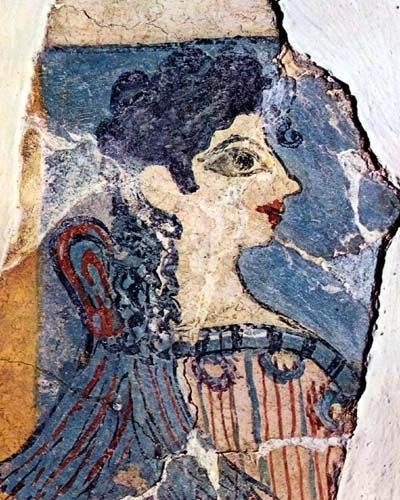
Sketchbook - Minoan and Mycenaean Art serie
1K notes
·
View notes
Text
Agamemnon: My wife still misses me!
Agamemnon: *narrowly avoids an attack from Clytemnestra*
Agamemnon: But her aim is getting better!!!
#greek mythology#incorrect greek mythology#greek heroes#incorrect greek heroes#incorrect greek quotes#incorrect quotes#iliad#incorrect iliad#mycenaean royals#agamemnon#clytemnestra#agamemnon x clytemnestra
286 notes
·
View notes
Text

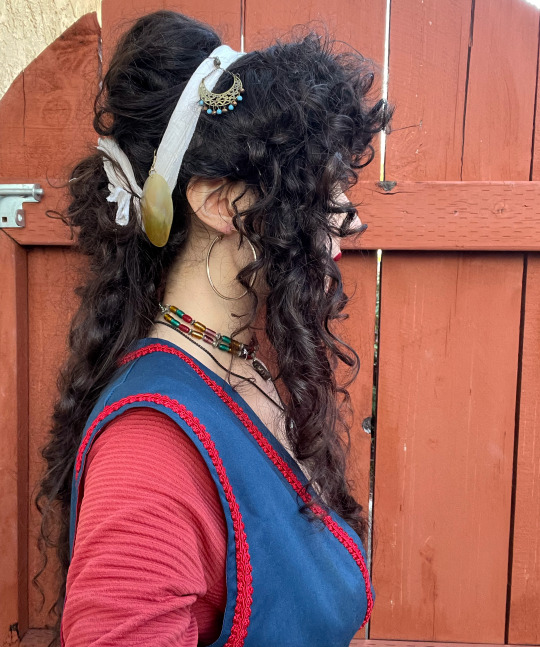


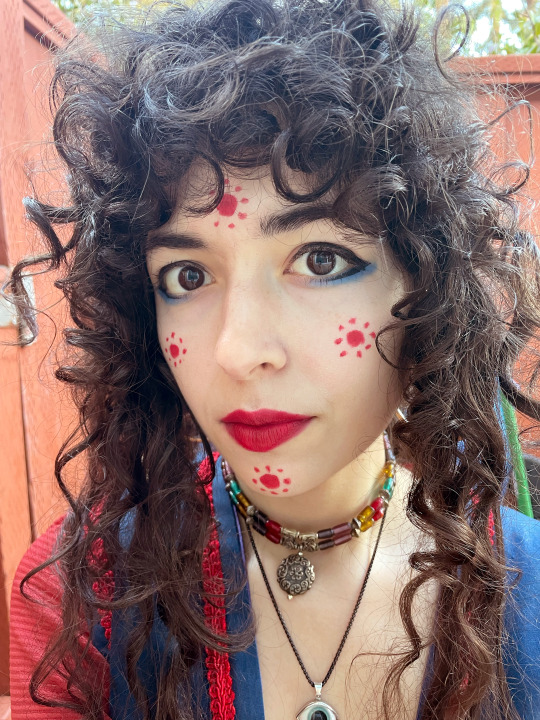

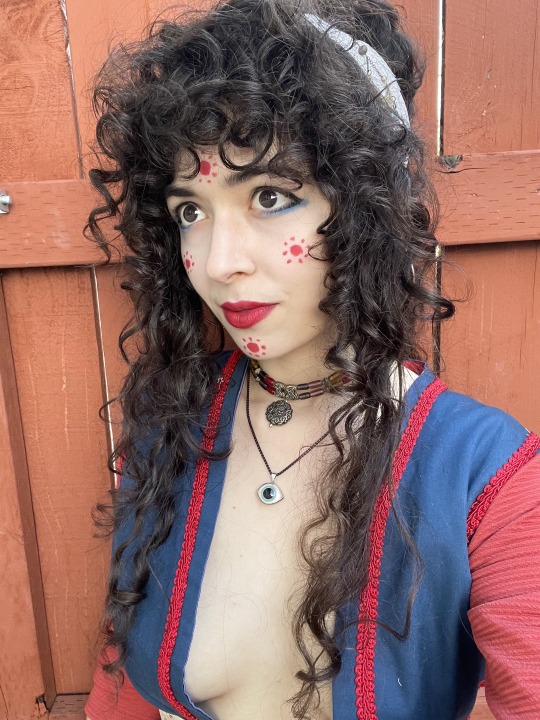
TERFs GO AWAY I’m nonbinary and as this is a look that is about exploring my own identity, gender is included in that. I’m not a woman, I am not your “divine feminine”. An edit I wish I didn’t have to make.
Here are some of the pictures of the Minoan/Mycenaean look I did yesterday! Mind you, it's all very generalized since I haven't made any clothing studies from these time periods yet, so I had just grabbed random clothes and jewelry from my closet that I could at least pass off as the ~vibe~ . I went for a pretty simple interpretation of makeup back then and ended up not really putting a whole lot on my face before the decorative elements, just a very thin amount of white foundation, but even so I figured my skin is pretty pale as it is that if this were historical I probably would have just been fairly bare faced anyway in a similar fashion. I tried to stay pretty close to how makeup might be applied back then and not go too anachronistic, and if I did it was for photographic or artistic purposes (namely, light contouring on my nose not for any sort of like, modern feature minimization, but to make sure my own Greek ethnic features weren't flattened by lighting levels or camera perspective)
Overall this was a really fun exploration of historic culture! Seeing the finished makeup on myself kind of brought over this cultural euphoria for me, even though many things have changed since ancient Mediterranean civilizations, there's almost a feeling of sameness in exploring the history of your heritage and seeing someone who looks or feels like you in ancient art. (But also a brief little disclaimer: the Mediterranean has been an extremely diverse region for thousands of years! I'm just one way of looking and that absolutely isn't representative of all people of Greece, neither then nor now!) I want to explore more historical fashions within this realm, and next time try a more extreme version of the makeup, something that feels more on the ceremonial side than casual like this one.
#wahoo! yippee!!! anywho enjoy and sorry i rambled a lot in the post im not good at being a brief person lol#historical fashion#ancient greece#minoan#mycenaean#greece#greek#history#antiquity#ancient greek#my cosplay
428 notes
·
View notes
Text

2 notes
·
View notes
Text
"Patroclus can't have darker skin than Achilles, The trojans would know it was him all along"
1) The gods can change his appearance to make him resemble Achilles more
2) If you are a Trojan soldier and see the horses of Achilles coming your way, are you going to stay to see if it's really Achilles, or are you going to run?
3) the armor Patroclus would've been using

#ramblings#greek mythology#iliad#achilles#tagamemnon#trojan war#patroclus#patrochilles#I found the armor in google#by searching “mycenaean armor”#I know it wouldn't been exactly that armor. but you get my point lol
329 notes
·
View notes
Text

The Tomb of Agamemnon by Louis Jean Desprez
#agamemnon#tomb#art#louis jean desprez#greek mythology#mycenae#mycenaean#king#architecture#funeral#ancient greece#ancient greek#history#antiquity#classical antiquity#europe#european#greek#greece#mythology#ancient#ancient world#funerals
580 notes
·
View notes
Text
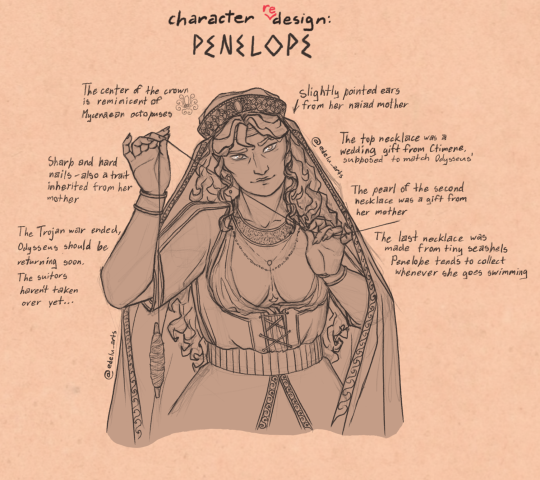
Really happy with how she turned out! I decided to give her some naiad features, inspired by this post and it was really fun! I hc that she can breathe underwater (even though she doesn't have gills. Do naiads have gills?), although I am not sure if she can do it freely or for a limited amount of time 🤔
The fabric piece covering her chest was loosely inspired by 18th century neckerchiefs, because I wasn't sure how the Mycenaean open chest fashion would fly with the censorship here or on other platforms ¯\_(• ▽ •;)_/¯
#I can leave comments and reblog posts again#yay#the odyssey#tagamemnon#penelope#character design#my art tag#I hc that she took over Odysseus' duties while he was away and got to be a reigning queen for about 10-13 years#until the suitors took over. It's a pretty long rant and I can't fit it into tags#this is her design before that#her being a ruler wouldn't really have been possible by Homer's time because of how the ancient Greece treated women#but since the story was set in Mycenaean Greece... maybe? Just maybe she could have enough authority for the assembly to take her seriously#epic the musical#epic the musical fanart#greek mythology#maybe this hc would change as I learn more things about history#but for now it's here ¯\_(ツ)_/¯
480 notes
·
View notes
Text

"Mycenaean women put their own spindles to splendid use, producing luscious cloaks and long, richly patterned or striped skirts. Far from resigning themselves to the weaving rooms, they travelled in chariots, performed songs or poetry to the accompaniment of lyres, and carried wheatsheaves for public ceremonies and rituals, as vibrantly coloured frescoes from the palace at Mycenae reveal. In one of the most enigmatic paintings, one woman holds a sword, another a spear, while two tiny men, one painted red and the other black, float mysteriously between them, like toy models or thought bubbles. Through their contact with the divine, perhaps, the women pictured gain agency over the men’s fate. Hera, Zeus, Poseidon and a female birth and death goddess known as Potnia were among the deities the Mycenaeans are known to have worshipped. While Mycenaean women clearly played an important role in religion, their political position within the palaces was weaker than that of their Minoan counterparts, and secondary to the men’s. Each Mycenaean palace complex was presided over by a male ‘wa-na-ka’ or wanax.
Surviving clay writing tablets provide just as fascinating an insight into the lives of women in the real palaces of the Mycenaean era. The fullest collection of tablets comes from a pair of rooms in the palace complex of Pylos, but Knossos, the former Minoan capital, was also a key repository. A total of 4,476 tablets have been preserved across the two sites. Among these there are references to more than 2,000 different women. Unlike Linear A, the Minoans’ writing system, the Mycenaeans’ similarly syllabic Linear B has been successfully deciphered. Working (as opposed to non-working elite) women were denoted by signs resembling an abstract impression of the female form. ‘Woman’ was conveyed by two dots for breasts, legs joined to suggest a long skirt of the kind Mycenaean women wore, and a curved line where her head would be, suggestive of long or dressed hair (in the sign for a man, by contrast, there is a straight line for the head).
The women referred to in the tablets were employed in a wide range of jobs, many of them familiar from the Homeric epics. In the Odyssey, women grind wheat and barley, ‘the marrow of men’, at mills. There were ‘flour-grinders’ at the palace in Pylos. In both epics, women weave, whether royal or servile. Andromache works in the Trojan palace with a loom and distaff while ordering her servant women about their work. Helen embroiders a purple cloth with scenes from the Trojan War as if she were telling the story of the poem herself. And as we have seen, Penelope weaves and unweaves a funeral shroud for her father-in-law, Laertes. The women who wove at Pylos and Knossos were no less versatile in their handiwork. They managed something like a textile industry, producing goods for export as well as the palace community, and worked in groups according to specialism. There were wool-spinners and carders, linen- and leather-workers, finishers and headband-makers for horses. These women usually worked separately from men, but at Pylos there is evidence that at least two women, Wordieia and Amphehia, formed part of a mixed leather-making group.
Working groups were the modus operandi at the Mycenaean palaces. Women were usually accompanied by boys and girls, presumably their own children, as they went about their tasks. Many were divided also according to their geographical region. Pylos was split into sixteen districts over two provinces, Nearer and Further, separated by Mount Aigaleo. The palace-workers came from more than 200 named places, some of which may have been local streets, while others, including Lemnos, Miletus and Knidos, lay further afield. It is possible that, like the Sidonian (Phoenician) women carried to Troy by Paris in the Iliad to weave fine robes for the court, some of the women working in the Mycenaean palaces had been enslaved.
Although the women were engaged in hard, practical labour, their work was recognised as highly skilled, and the Mycenaeans took some pride in it. Men were sometimes described on tablets as being the offspring of women of particular crafts, for example, ‘sons of flax-workers’. Female workers were allocated the same amount of food in the regular distributions as their male counterparts, and twice as much as their children, whereas in Babylonia, men typically received three times the female ration.
A mysterious senior class of priestess at Pylos known as ‘keybearers’ (did they open and close shrines within the palace complex?) even owned land. A landowning keybearer named ka-pa-ti-ja (‘Karpathia’) was wealthy enough to donate almost 200 litres of grain to the palace, probably for a religious festival. Given the historical prominence of women at the court of Pylos, it is fitting that a mythical Pylian king should intervene in the dispute over Briseis in the Iliad. Old Nestor urges Agamemnon to return the woman to Achilles and to end their feud."
The Missing Thread: A Women's History of the Ancient World, Daisy Dunn
#history#women in history#women's history#historyedit#mycenaean greece#ancient greece#bronze age#ancient world#working women#women's work#greece#greek history
131 notes
·
View notes
Text

Between Scylla and Charybdis (Odyssey) 2024
#marysmirages#ancient greek mythology#mycenaean greece#odyssey#scylla and charibdis#odysseus#bronze age#painting#iliad#octopus#ship#homer
1K notes
·
View notes
